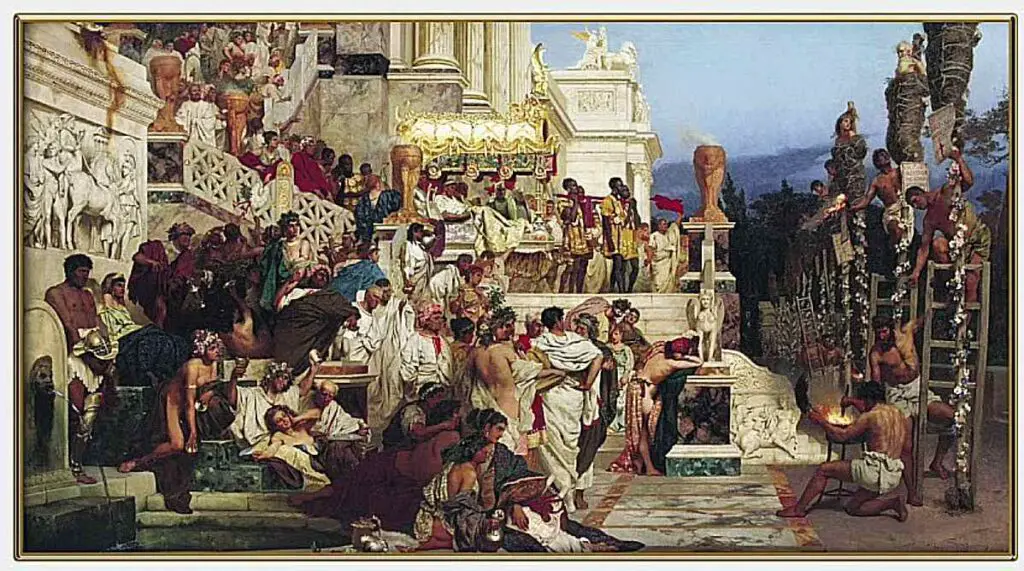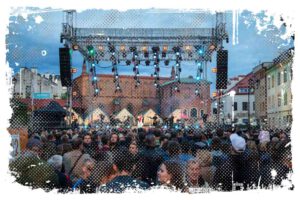Art has a unique way of telling stories, don’t you think? And when it comes to the city of Krakow, with its rich of art collections, especially famous paintings, the stories are endless. Let me say, I browsed several art websites to compile a list of the most valuable paintings tucked away in Krakow’s museums and galleries. Buckle up as we explore these 15 marvelous works.

Now, some pieces are by artists who are practically household names, or are so renowned like The Lady with an Ermine that they’re a given for any top art list. But, I am convinced that as we dig deeper into this list, we’ll see how personal interests, subjective feelings, and unique artistic sensibilities come into play.
As Dr. Siwek, from the Institute of Art History of the Jagiellonian University, explains in his interview, it gets increasingly complex to pick and rank these works due to the multitude of contexts tied to each painting. What’s more, the ranking can shift depending on the themes we’re focusing on or the circumstances in which we encounter the art.
1. „Lady with an Ermine” / Leonardo da Vinci

No surprise here, right? I think this painting of Cecylia Gallerani, the lover of Prince Ludwik Sforza, housed in the Czartoryski Museum, is not only Krakow’s crown jewel, but a priceless piece of Polish art collections. If this artwork ever hit the market, it would likely be the priciest piece in art history. This painting holds the title of being the first psychological portrait in art history, and the first „modern” painting. And that ermine cradled in the lady’s arms? Well, it symbolizes the secret love between Cecilia Gallerani and Prince Louis Sforza, whom Leonardo couldn’t depict together.
↳ Make sure to read my guide to the most amazing places to stay in Kraków:
How to Find Best Place to Stay in Krakow Old Town – Your Guide
- For more information, please read: The Journey of The Da Vinci’s „Lady with an Ermine” to Kraków
2. „Landscape with the Good Samaritan” / Rembrandt

It’s easy to get lost in the vibrant colors and the intricate composition of this painting. The Good Samaritan is a parable from the Gospel of St. Luke and is one of the few independent oil landscapes by Rembrandt van Rijn that we know of today.
Also housed in the Czartoryski Museum, this artwork is one of the most valuable pieces of European art in Polish collections. I can tell you that this landscape made its way to Poland thanks to Jan Piotr Norblin who purchased it at an auction in Paris in 1774. Interestingly, its creation time and painting method link it to two other tumultuous landscapes located in Amsterdam and Braunschweig.
3. „Jupiter Painting Butterflies” / Dosso Dossi

This one might not ring a bell, but trust me, it’s a treasure you don’t want to miss. Created around 1524, you’ll find it in the magnificent Wawel Museum. Dr. Andrzej Betlej, the vice-president of the Association of Art Historians and director of the Wawel Royal Castle, said in the interview that this painting is part of a unique set of paintings from the Lanckoroński collection.
Undoubtedly, it’s a grand masterpiece of Italian Renaissance painting. To him, it’s second only to Rembrandt’s Landscape with the Good Samaritan among Krakow’s masterpieces.
4. „Equestrian Portrait of Prince Władysław Sigismund Vasa” Circle by Rubens

Although we’re not quite sure who painted the portrait of Władysław Vasa, I can tell you this – the artist was likely part of the inner circle of one of Baroque’s greatest figures, Peter Paul Rubens.
The painting is a prime example of an equestrian – essentially the most representative form of royal portraiture. It showcases the artist’s astounding painting abilities, visible in both the foreground figure of the prince and the background featuring episodes from the Battle of Khotyn. Definitely a piece to study and admire. You can find this gem in the Wawel collection too.
5. „The Prussian Homage” / Jan Matejko

Now, this canvas, which portrays the homage given to King Sigismund I the Old by Albrecht Hohenzollern in Krakow’s Main Square in 1525, is essentially a tribute to Poland’s might. It illustrates the grandeur, the cultural brilliance, and the fair rule of its kings.
Matejko intended this painting for the nation and wanted to place it on Wawel. It was supposed to kick off the collection of the Royal Castle, which was set for revival. As a deposit, it ended up in the National Museum in Krakow and has been on display in the Sukiennice since 1885. Nowadays, this and other paintings by Matejko are inseparable from our historical recollections.
6. Still Life / Willem Claesz Heda

This painting is one of the freshest additions to the Krakow collection. Composed in grey-green hues and displaying a beautiful arrangement of glass and silver vessels, this piece was created in the 1730s or 40s, which is the time most of Heda’s best works are from. Until mid-February 2022, this painting was hidden from public view, but it was finally revealed at Wawel in Kraków.
Dr. Joanna Winiewicz-Wolska, curator of the painting collection of the Wawel Royal Castle, explained at the painting’s first official presentation. This is an illustration of the perfection that Dutch painters achieved in the art of illusion.
Until recently, researchers thought that Heda painted eight 'Still Life' in 1637. But now we know there were actually nine.
This painting, unknown in the literature on the subject, has been in private French collections since the late 19th century. Only now is it seeing the light of day and will likely become a point of interest for researchers.
7. „Nero’s Torches” / Henryk Siemiradzki

Just as the Prussian Homage marked the beginning of the Wawel museum collections, „Nero’s Torches” was given the first inventory number of the National Museum in Krakow. The painting, which illustrates the tale of Nero’s persecution of Christians, was gifted by the artist himself in 1879. Art historians are unanimous on this: if you’re in the Cloth Hall, you just have to see Nero’s Torches.
8. „St. Michael’s Inn” / Pieter II Brueghel

Next, we’re taking you back to Wawel Museum in Kraków. Pieter II Brueghel’s „The Inn of St. Michael” captures the everyday life of a 17th-century Flemish village with remarkable precision. The painting, created between 1619 and 1625, is one of the most significant works by the son of the renowned Dutch painter, Pieter I Breughel, and one of the first that he painted as an independent artist, without referencing any of his father’s known works. He demonstrates a unique style here, brimming with inventiveness and a keen eye for detail.
9. „Samosierra” / Piotr Michalowski

Michałowski is one of our most important national painters, and Samosierra itself is a story encapsulated in a single dramatic image. A significant part of us grew up in the cult of romanticism and romantic literature. In painting, Michałowski corresponds to this literary Romanticism, but with an image. It brims with dynamism, legend, and remarkable painting skills.
10. „Valley of The Vistula From Zwierzyniec” / Jacek Malczewski

Even though landscapes often serve as the backdrop for Jacek Malczewski’s portraits, the small-format painting „Vistula Valley…” exhibits the artist’s deep sensitivity to landscape and color. This work belongs to a relatively lesser-known collection of small compositions portraying views from the surroundings of the artist’s villa situated in the Zwierzyniec district of Krakow. You can feast your eyes on this painting in the Main Building of the National Museum in Krakow.
11. „Planty at Dawn” / Stanisław Wyspiański

Otherwise known as Morning at Wawel, this painting showcases Wyspiański’s exceptional talent in capturing the atmospheric landscape of Krakow. In this characteristic piece, the artist beautifully illustrates a misty morning view of Wawel. Created in 1894, it also happens to be one of the few works of Wyspiański painted in oils.
12. „Self-portrait With His Wife” / Stanisław Wyspiański

Planty is enchanting, imbued with a quintessentially Krakovian melancholy, almost Art Nouveau in spirit. However, we should draw our attention to what is believed to be an even more significant piece – the Self-portrait with his wife from 1904. This work is brimming with emotional energy, tremendous tension and drama, and profound characterization.
Wyspiański contrasted his wife’s figure in a Krakovian costume with his self-portrait. You can almost perceive the swirl of thoughts in his head and his self-image as a bard in this painting. But more than any individual work, I’d like to spotlight the entire Wyspiański museum—Wyspiański was a world-class artist and immensely important to our national culture.
13. Portrait of Stefan Batory / Marcin Kober

To behold this painting, you need to venture to the less frequented Historical and Missionary Museum of the Congregation of Missionary Priests in Krakow near Stradom. In Marcin Kober’s Portrait of Stefan Batory, you can witness the majesty of the ruler as well as the defining characteristics of the subject. Kober, who is counted among the most distinguished painters of his time in Central Europe, played a key role in introducing the monumental style of representative portraits in Poland.
14. Still Life with a Landscape and a Saucepan / Jerzy Nowosielski

Jerzy Nowosielski, celebrated as one of the most exceptional contemporary iconographers, holds a pivotal position in Polish modern painting and the overall Polish painting school. His painting is a testament to the synthesis of form, demonstrating that even the most mundane objects can be elevated to convey a significant message when filtered through the artist’s eye and hand. Nowosielski’s extraordinary painting prowess transforms reality and narrates a captivating story.
15. „Polak” 1979 / Leszek Sobocki

Leszek Sobocki’s cryptic portrait of Pope John Paul II, created soon after the conclave, was featured in the landmark 1979 exhibition „Poles’ own portrait” at the National Museum in Krakow. This exhibition is considered one of the most important events in the annals of Polish museology.
Given the necesity of bypassing censorship, Sobocki employed the nude format and excluded all props save for a barely visible piuska. Despite these restrictions, he managed to convey the pope’s dignity in this painting. Embedded deeply within historical context, this piece is both a symbolic and psychological portrait in which Sobocki captured the iconic gaze and the typical clasped-hands gesture of the pope.
What Defines the Value of The Painting?
Now, I believe it’s worth noting that when art historians talk about a painting’s value, they’re not just referring to its price tag. I know that it’s not all about how much someone is willing to pay for a piece of art. Historian underlines:
The auction market is unpredictable. But for researchers and art historians, the real chase is for something more elusive. The artistic value, quality, and uniqueness of a piece.
You see, there isn’t a one-size-fits-all rule for evaluating artworks. The concept of artistic value is tricky. Some paintings only receive recognition after many years, suddenly finding themselves as centerpieces in museum halls or fetching top dollar at art auctions. Artistic value also hides a bunch of other criteria. So, how do art historians decide what qualifies as a real piece of art?
Well, Dr. Siwek gives some insight.
Firstly, there is a certain canon of works – those that relate to significant events in European and global art. These artworks tend to be path-breaking or representative of a particular artistic phenomenon.
I can tell you that from a monument protection standpoint, there are three values:
- artistic, which is the toughest to measure
- historical, meaning the context of the work;
- and scientific value
This scientific aspect refers to authenticity, an artwork’s testament to its era, the artistic techniques employed, the materials used, and the role the work plays in a broader developmental process that occurred in history.
In Summary
The exquisite art collections found in Krakow are indeed a treasure trove of masterpieces. From Leonardo da Vinci’s „Lady with an Ermine” to Leszek Sobocki’s contemporary „Pole 1979” the city’.s museums and galleries host an array of paintings that encapsulate the esence of various art movements, periods, and individual artistic styles.
The value of these paintings cannot be measured solely by their market prices, as their historical and artistic significance far outweighs any monetary considerations. Each painting tells a unique story, offers an insight into the artist’s mind, and provides a testament to the prevailing cultural and societal norms of the time.
References:
- https://pl.wikipedia.org/wiki/Kategoria:Sztuka_w_Krakowie
- https://www.mocak.pl/
- https://niezlasztuka.net/o-sztuce/muzeum-narodowe-w-krakowie-10-dziel-ktore-warto-znac/




